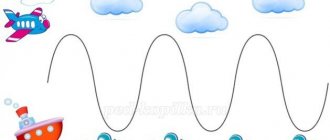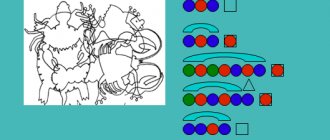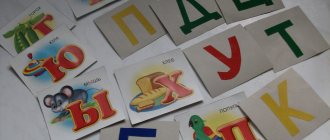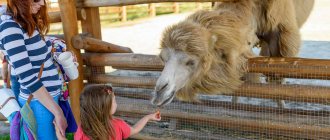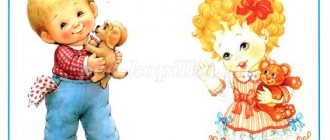Didactic exercise for children 6-7 years old: Voiced - deaf
Didactic exercise for preschool children: “Voiced - deaf”
Author: Lyanguzova Olga Zhanovna Brief description of the resource: a game for differentiating sounds by deafness - voicedness Goal and objectives of the resource: development of phonemic processes, consolidation of practical skills, development of attention, memory, imagination. Relevance and significance of the resource: the game can be used by speech therapists, educators, defectologists, and parents in correctional work with children to differentiate sounds in words and sentences. Practical application: subgroup and individual correctional classes. Equipment: cards with 6 pictures (3 pictures for a voiced sound, and 3 for a voiceless sound), a set of pictures for each card, working fields with different alternations of symbols (voice - a bell; a voiceless sound - the bell is crossed out), as well as split symbols. Method of work: Working cards are proposed for differentiating the sounds B//P, V//F, G//K, D//T, Zh//Sh, Z//S. P//B T//D S//Z K//G W//F These cards are convenient both for playing in a subgroup (for this you need to print out the required number of cards) and for individual work. Preliminary work: distinguishing isolated sounds in syllables. When working with children with disabilities, you can offer a visual support, where the bell that corresponds to it will be indicated under the sound. Option 1 An adult invites the child to fill out a card with pictures with symbols of a voiceless and a voiced sound, depending on what sound is heard in the word. After completing the exercise, you can offer to compare it with the sample. If there is a mistake, the child corrects it and explains why his choice was wrong. Good techniques for developing memory are tasks such as: 1. “Remember and name words only with sound...”. Since the card will be completely closed, the child, focusing only on the sound symbol, will have to recall the necessary words in memory. 2. “Remember and name only the animal, only the profession, etc.” Option 2: The child must place the pictures on the sound mat in the same sequence as on the mat. Option 3 Imagination task. The child is offered a stack of cut pictures, with differentiated sound, face down. He draws any 2 cards and comes up with a sentence with them. The sentence can be either ordinary or absolutely absurd (“The giraffe sat on the closet”), which will undoubtedly bring smiles to the faces of your children. Cut-out pictures can also be used in any other didactic exercises, both to automate certain sounds and to differentiate them (“What’s missing?”, “Who swapped places with whom”? “Divide into syllables,” “Name only vowels”) (hard consonants, soft consonants) sounds in a word”, “Carousel”, etc.) I wish you good luck!
We recommend watching:
Scenario of a game program for teaching literacy to children in the preparatory group Didactic game for teaching literacy to older preschoolers Didactic game for teaching literacy to older preschoolers Notes on teaching literacy in the preparatory group
Similar articles:
Summary of a lesson on teaching literacy in the preparatory group
Summary of a lesson in the preparatory group on the development of speech and literacy
Literacy games for children 4-5 years old
Literacy games for children 5-6 years old in kindergarten
Educational games for children 6-7 years old in kindergarten. Card index
Differentiation of voiced and voiceless paired consonants in pictures
Author-compiler:
teacher speech therapist
Golovchenko Antonina Vitalievna
Practicing speech therapists know firsthand how persistent the deafening (voicing) defect of consonant sounds can be.
Most of all, defects in voicedness and deafness manifest themselves when pronouncing paired sounds in preschoolers. Correcting deficiencies in the pronunciation of voiced consonants should begin with fricative sounds, and with the simplest of them in terms of articulation of the sound [v], after which they move on to the sounds [z] and [z]. Significantly greater difficulties can arise when setting up voiced plosives [b], [d] and [g].
General techniques for producing voiced sounds:
Vowel sounds are pronounced sequentially, each one first in a whisper, and then loudly, after which they immediately proceed to a similar pronunciation of the desired consonant. For example, voicing the sound [z]: in a whisper - [a]; loud - [a]; whisper - [and]; loudly - [and]; whisper - [s]; loud - [z].
It is important that adjacent articulations of the vowel and consonant are similar: [i] - [s], [o] - [w], [u] - [v], [a] - [k].
The speech therapist pronounces a ringing sound, and the child touches his larynx with his hand and feels a trembling in its area (to perceive the vibrations of the vocal folds, the back of the hand should be applied to the larynx). Then he pronounces this sound himself, simultaneously holding one hand on his larynx and the other on the speech therapist’s larynx. The result is often a ringing sound.
Differentiation of voiced and voiceless paired consonants in the speech of preschool children is a very long and difficult process. In order to diversify the work of distinguishing these sounds, you can use various games and tasks in pictures. Interesting pictures - tasks will help children not only hear, but also visually see the difference when pronouncing paired words correctly or incorrectly.
Recommendations for working with paired pictures:
If the child voices consonants, ask him to say the desired word in a whisper. If it deafens, pronounce the word, controlling the vibration of the larynx. It is useful to lightly shake the larynx with your fingers to cause vibration of the vocal folds.
You can offer your child the following tasks:
- Show the picture that the speech therapist calls, for example: “Where is the goat? Where is the scythe?
- Show and name the pictures in the same order in which the adult names them, for example: “Barrels, kidneys, barrels.”
- Name the picture that the speech therapist shows.
- Correct an adult who names the picture either correctly or incorrectly. For example: “Is this a tooth? Yes. Is this soup? No! This is a tooth."
Pictures for the game in full scale can be downloaded from the link
Pictures for a game on differentiating voiced and voiceless paired consonants
Share on social media networks
To My World
0
Tweet
RќСЂР°РІРёС‚СЃСЏ
I advise you to read more on this topic
- Differentiation of sounds [S] - [Z] on the lexical material “Winter”
- “We distinguish the sounds [S] - [SH]”
- Differentiation of sounds [L] - [R] in words
- Lesson notes for the senior speech therapy group “Dunno in the City of Masters”
- Summary of a lesson on sound automation [C] using the speech therapy manual “Zaozerye”
